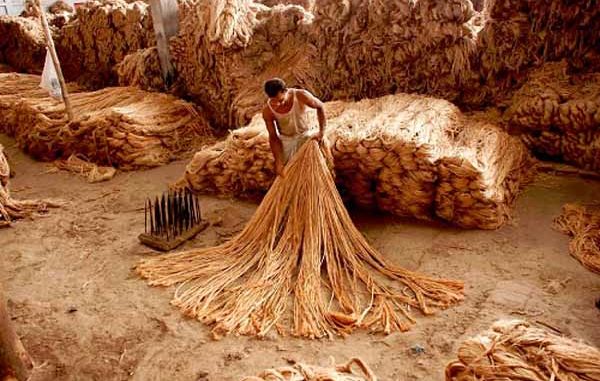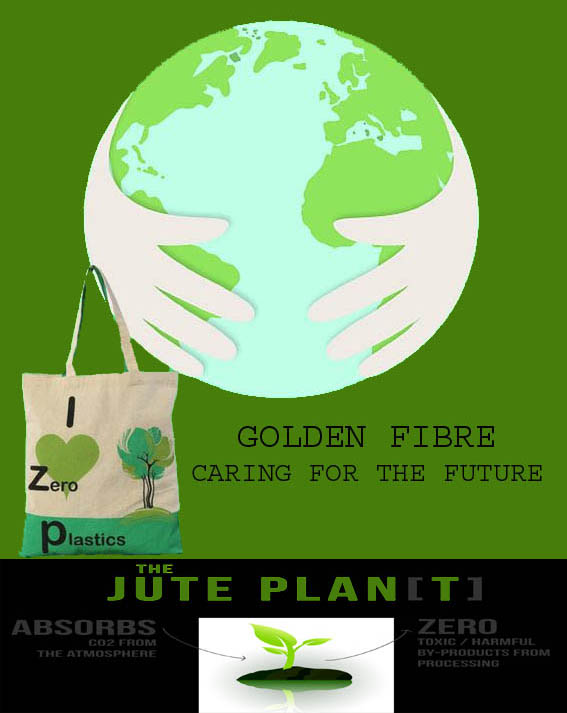
With the ushering in of the new millennium, today’s technology-dependent society is moving at an unprecedented pace. Global changes in ecology are making us more aware of energy conservation, nature preservation and natural solutions to everyday needs. Golden fibre jute, the most important and versatile natural fibre has emerged as the fibre of choice with endless possibilities. it is completely biodegradable, eco-friendly and renewable and comparatively inexpensive. this natural fibre has proven itself to be a dependable alternative to non-renewable timber word synthetics and plants.
The Plant
Jute is removed from the bark of the jute plant, primarily the genus Corchorus. The primary source of the fibre is Corchorus olitorius, but it is considered inferior to Corchorus capsularis. It is one of the most affordable natural fibre with its golden colour and silky shine and hence called Golden Fibre.
The suitable climate for growing jute is offered by the monsoon climate, during the monsoon season. It is a rain-fed crop and it doesn’t need much of fertiliser or pesticides. It is considered as one of the most affordable natural fibre and second only to cotton in amount produce and variety of uses of vegetable fibres.
The finest jute is grown on the Indian Subcontinent with India and Bangladesh as the major global exporters of both jute fibre and woven jute products.
Environmental benefit
Jute has a low carbon footprint, is biodegradable, recyclable and environmentally friendly. It helps to clean the air; during growth they absorb three times more carbon dioxide than the average tree, converting carbon dioxide to oxygen. The leaves and roots left after harvest enrich the soil with micronutrients, maintaining soil fertility. When used as a geotextile, it puts nutrients back into the soil when it decomposes.
When used as a geotextile, it puts nutrients back into the soil when it decomposes.
Golden Fibre Jute: Its Promises
Jute plants are a huge source of renewable biomass . carbon dioxide assimilation rate of Jute is several times higher than that of trees. it is estimated that one hectare of jute plants can consume about 15 tonnes of carbon dioxide from the atmosphere and release about 11 tonnes of oxygen in a hundred days of the jute growing season. a recent study has revealed that the greenhouse gas emissions by Jute is negative and has drawn the attention of the consumers to make more use of biodegradable jute products. due to the natural advantages and development of new and diversified jute products, the market has once again become receptive to jute from traditional products like sacking. Hessia n having a wide range of views and exported widely both as cloth and bag, the versatile jute fibre is now used to produce rigid packaging, reinforced plastic, jute composite and exciting new products of all time ranging from shopping to fashion are produced in different sizes, shapes and colours. Jute fibres are also being used to make pulp and paper with increasing concern over
n having a wide range of views and exported widely both as cloth and bag, the versatile jute fibre is now used to produce rigid packaging, reinforced plastic, jute composite and exciting new products of all time ranging from shopping to fashion are produced in different sizes, shapes and colours. Jute fibres are also being used to make pulp and paper with increasing concern over
forest destruction for the wood pulp used to make most paper. jute yarn and twines are woven into curtains, chair coverings, carpets, rugs and backing for linoleum. Jute blended fabrics are used for making furnishing cushion covers, decorative items, toys ,wall hangings, lamp shade, floor coverings, packaging materials, shoes, fashion jewellery, particle boards and other items are also made by jute. jute geotextiles have high moisture absorption capacity, flexibility and drainage properties and are used to prevent soil erosion and landslides of river embankment, roadsides and hill slopes.
Global concern about environmental degradation is creating a shift from artificial synthetics to natural fibres. the international Jute Study Group (IJSG) is an intergovernmental body set up under the edges of untapped to function as the international commodity body for jute, kenaf and other allied fibres. the group is functioning for the overall development of the world jute economy, generic promotion, issues of poverty alleviation, employment and development of human resources particularly women in the jute sector. it has also established a private sector consultative board, BSEB that functions on the basis of the public-private partnership to resolve the common problems that exist in the sector. apart from the multi-sectoral efforts of IJSG, scientists, researchers, producers and others are offering Jute and allied fibre products in the most useful form and had market competitive price .the group acts as a catalyst for expanding international trade of jute and jute products including the introduction of new Jute product having diversified applications. To highlight and enhance the profile of natural fibres, the United Nations has declared 2009 as the International Bureau of natural fibres which will be observed globally to boost out for users of jute and natural fibre products. it can be safely asserted that the future of mankind has been tied with the future of Jute. Jute plants with its fresh young look and green leaves promise us a world of endless possibilities for today and tomorrow.

Leave a Reply